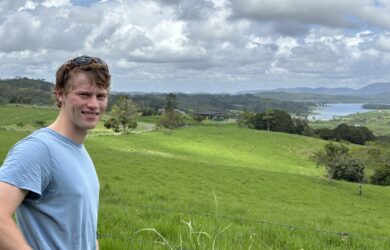For someone who did his PhD in medieval monastic architecture, studying something as contemporary as the politics of a city like Jerusalem may seem a large leap, but for Max Gwiazda [2001] it made absolute sense.
Max, who was born in Germany, home to its own city in conflict – Berlin, understanding the historical context of a city is vital. The son of architects of both German and Polish descent, he has always been interested in the relationship of space and culture.
Indeed when he was interviewed for his Gates Cambridge scholarship, he was asked about how he intended to contribute to making the world a better place. “I was not sure how convincing I was. I said something about the role of architecture and urbanism in social relations based on my experience of living in London and some of the problems of segregation and wealth disparities I had witnessed there. It was the first thing that came into my head. It’s strange that this was an unwitting prophecy of what I would go on to study,” he says.
Max, who was one of the first cohort of Gates scholars started with an MPhil in 2001, and finished his PhD in 2006, and returned to Cambridge in 2007 after doing postdoctoral work in Paris and Rome. He was contacted by his former supervisor at Cambridge who was developing the Economic and Social Research Council-funded project ‘Conflict in Cities and the Contested State’. The project had been going for three years, but had won more funding so was expanding its research team. “I had always made clear that I was interested in contemporary issues so he approached me,” says Max.
The project studies a wide range of ethno-nationally contested cities in Europe and the Middle East. Max concentrated mainly on Jerusalem and how the city has been shaped by conflict. “It’s not just about the impact of the conflict on the city, but also about how the city has shaped the conflict and how people living there have the capacity to resist or transform the conflicts they are subject to,” he says. The project’s researchers have ongoing relationships with a wide range of NGOs and in addition to academic outputs provide policy briefings and organise feedback forums for non-academic users.
Max says that Jerusalem’s architecture today continues to be affected by aspects of colonial planning introduced by the British during the Mandate. “The architecture was perhaps not meant to dispossess certain people, but it has tended to disadvantage the Palestinians and has been abused for political purposes in Israeli planning policies,” he says. “It continues to undermine the possibility for more even development and diversity in the built environment.”
He adds that it is striking to note how architecture is used to show dominance and how the planning of the city is increasingly guided by security and surveillance concerns largely detrimental to everyday life in the city, not just for the Palestinians. Palestinians, he says, are systematically disadvantaged by a partisan planning system, which is guided by overriding Israeli concerns about territory and demography, in turn draining human capital and breeding radicalisation amongst Palestinians.
However, he adds that cities also have a life of their own because people simply have to get by. “They have a capacity to resist antagonistic planning mechanisms and the wider influence of state conflict,” he says. The Palestinians continue to use space to their advantage, he adds, for instance, in their markets, testifying to the resilience of everyday life. These markets are not only used by Palestinians, however, and Jerusalem’s Old City in particular continues to witness largely non-violent co-existence in situations of habitual urban life.
However, he also acknowledges the way all aspects of life in the city have become politicised, for instance, conservation work is “abused to represent nationalist and exclusionary narratives”. Tour guides tell “a particular story” relegating an expurgated, nationalist reading of the past. The city, particularly the wall that divides it, has become a site of “conflict tourism”. “Even something as apparently benign as planning a new park or the playing of a certain type of music in the Old City can be a highly politicised act,” says Max.
The research also looks at other cities which have been the centres of conflict, such as Berlin, Belfast and Brussels. “Each conflict we look at is highly complex and to some extent unique. For instance, in Belgium Brussels plays a major role in holding together a state in crisis. Yet if you didn’t know about these wider tensions in Belgium you would never think that Brussels is an ethno-linguistically contested city,” he says.
He adds that there is an emerging field of comparative research on urban conflict, but he says these studies tend to be fairly limited, focusing on individual aspects only, such as policy, thereby losing a richer sense of context.
As part of his work Max studies policy discussions on how Jerusalem could be re-divided if an agreement on a two-state solution was reached. These proposals often make provisions for introducing more separations into a city already subject to processes of fragmentation and division.
Policymakers tend to opt for drawing lines on maps to partition cities, treating urban boundaries as if they were state borders. Max says the project’s research exposes the problems of this approach in many peace proposals. “Hard borders and buffer zones have an extraordinary deadening effect on cities,” he says. Policymakers, he adds, tend to be interested in clear-cut outcomes and short-term solutions, whereas he and his colleagues attempt to demonstrate that ignoring the messy everyday dynamics of cities in conflict will lead to solutions which are not sustainable in the long-term.
“A good agreement must be based on having a good city with a rich and pluralist public life rooted in settings that can sustain this diversity,” he says. “Policymakers don’t tend to take an interest in cities. They just want to draw territorial lines. Most negotiations are strangely abstract and removed from the situation on the ground.”
By spatially representing the city through maps and drawings Max and the team that he is part of, engage with policy-advisers by visualising the complexities at play in a way that exclusively textual analyses often fail to capture.
The Conflict in Cities project will finish in 2012. Max has a university lectureship at Cambridge until 2013 teaching History and Theory of Architecture.
He is also a founding member and former president of ‘Architecture Sans Frontières – Cambridge’, an international network of academics, practitioners and public agencies dedicated to the social dimensions of urban development. As with all his work, his commitment is to demonstrating that architecture is about much more than putting up buildings.












